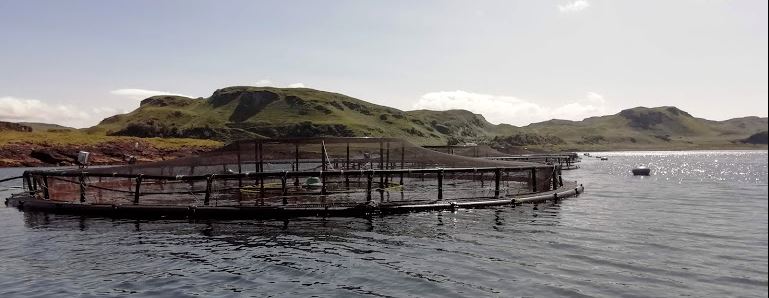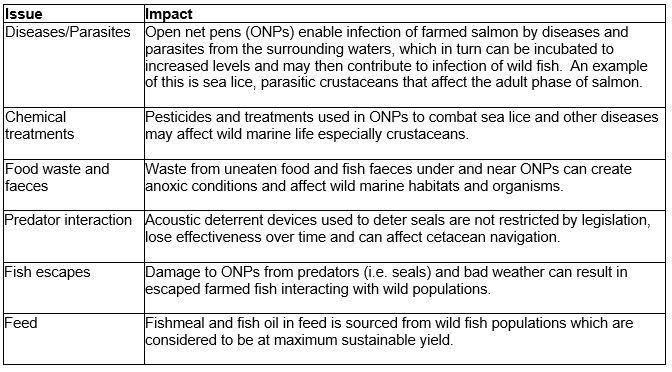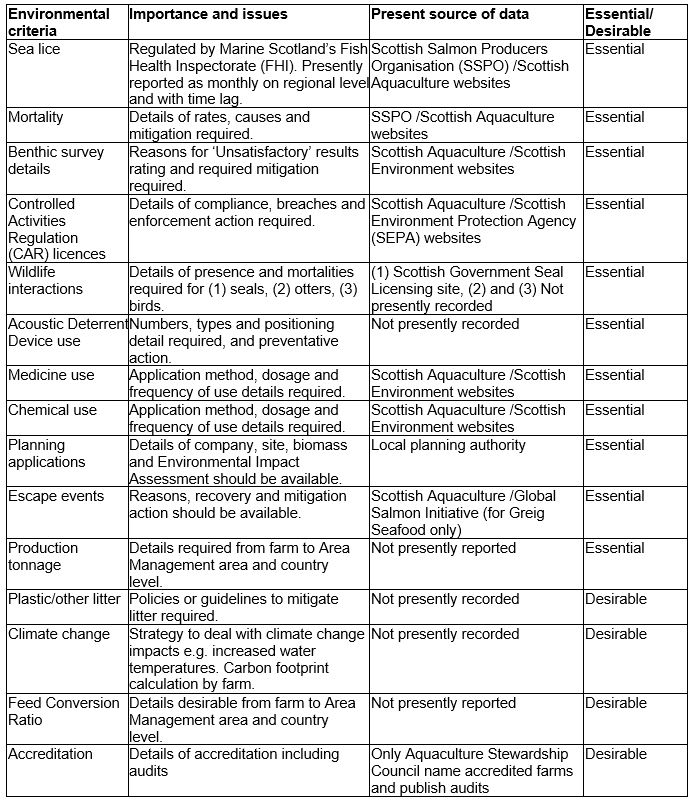
Scottish fish farm © Fidra
Environmental impacts of salmon farming are well known
The use of open net pens in Scottish salmon farms has a range of widely acknowledged environmental impacts, from the exchange of diseases and parasites with wild fish to the use of chemicals, and feed sourced from wild fish populations (Table 1).
Table 1. Main impacts of salmon farming

To address these environmental issues Fidra asks that MSPs support policies, regulation and legislation to improve standards in salmon aquaculture through innovation and best practice, effective enforcement of stringent regulations, and increased transparency.
The Scottish Parliament’s Environment, Climate Change and Land Reform (ECCLR) committee’s Report on the environmental impacts of salmon farming[1], calls for:
- restraint on industry expansion until the present challenges are adequately addressed;
- increased investment in Scottish research and innovation;
- better regulation of and transparency from salmon farms.
Fidra supports these findings and asks for Scottish Government to move forward and commit to the calls on regulation and transparency.
Sustainability dashboard will achieve transparency and accountability
Increased transparency will lead to improved accountability and practice, and can be achieved through an online database or ‘sustainability dashboard’. Data associated with individual salmon farms is currently collected for regulators such as the Scottish Environment Protection Agency (SEPA)[2]. Hosting all the data in a centralised location and comprehensive format will also make it accessible for the use of consumers, retailers, industry and communities local to the fish farms.
The report from the subsequent inquiry by the Rural Economy and Connectivity (REC) Committee, Salmon farming in Scotland[3], expresses the importance of regulation being in line with accreditation to increase transparency. Accreditation often has stricter parameters than present legislation, and stronger enforcement actions.
Fidra’s recent report on the impact of Scottish salmon farming on the benthic (seabed) environment[4], examines benthic surveys conducted to comply with farms’ SEPA licences. A significant finding was that a farm can have repeated ‘Unsatisfactory’ benthic surveys yet still have a ‘Good’ overall compliance rating. Despite this, lack of compliance was predominantly due to poor benthic survey results.
Compliance of salmon farms in Scotland could be significantly improved by addressing poor benthic survey results with stronger enforcement action such as reducing the salmon produced (biomass), or implementing fallow periods or site closures.
Government interventions
Positive environmental change is achieved through collaborative dialogue with NGOs, government and industry. This can be enhanced through effective government legislation and support. Fidra welcomes the ambitions for ‘improved regulatory processes’ for aquaculture in the Scottish Government’s 2020-2021 Programme for Government[5]. As it is now 2 years since the parliamentary inquiries, Fidra is seeking detail of what these regulatory processes are and a committed timetable to put forward supporting legislation.
A significant amount of data is already collected by farms to meet the requirements of SEPA, the Fish Health Inspectorate (FHI) and Scottish Salmon Producers Organisation (SSPO) Code of Good Practice, so the introduction of a sustainability dashboard would not require the collection of additional information.
However, the information that is collected is stored in several different places, and is often not easily accessible or in a comprehensive format. A well-designed dashboard would showcase what is already being done at farm level in a clear and transparent way. Criteria proposed for a sustainability dashboard are detailed in Table 2. A multi-tiered access to data is preferable to enable users to select by geographic area, to individual farm level, by environmental criteria and by company. A user could therefore view how criteria such as sea lice vary, or how an individual farm or company performs in terms of all the listed criteria.
Table 2. Environmental criteria proposed for sustainability dashboard concept.
Conclusions & recommendations
To achieve increased transparency, information flow and regulatory compliance Fidra is asking MSPs to call for:
1. an immediate moratorium on further development in areas with poorly performing salmon farms, unless, and until, performance of the farms can be improved and sustained to limit damage to the benthic environment;
2. no additional salmon farms in Scotland’s Marine Protected Areas (MPAs), and consideration to moving those that are presently in MPAs by 2025;
3. increased monitoring of farms from 2022 after an ‘Unsatisfactory’ benthic survey result and stricter enforcement actions such as a clear set limit of 3 consecutive failed or non-compliant assessments, after which reduced biomass, a fallow period or site closure is enforced;
4. development of a single central online database by 2022 with data on a wide range of environmental parameters displayed to farm level, including detailed benthic survey reports, and action taken for ‘Unsatisfactory’ results and compliance failure.
Information flow and transparency is one of 7 cross cutting workstreams of the Scottish Government’s 10 Year Farmed Fish Health Framework[6]. In line with this, Fidra believes there is an urgent requirement to ensure that the processes involved in the farmed salmon industry are transparent and suitably communicated to all stakeholders. With substantial data already collected by farms, there is a need for investment in digitising reporting processes, and in the creation and administration of a central database.
[1] ECCLR Committee (2018) Report on the environmental impacts of salmon farming. 81pp. http://www.parliament.scot/S5_Environment/Inquiries/20180305_GD_to_Rec_salmon_farming.pdf
[2] https://sectors.sepa.org.uk/media/1155/finfish-aquaculture-sector-plan.pdf
[3] REC Committee (2018) Salmon farming in Scotland. 146pp. https://sp-bpr-en-prod-cdnep.azureedge.net/published/REC/2018/11/27/Salmon-farming-in-Scotland/REC-S5-18-09.pdf
[4] Fidra (2020) The impacts of Scottish salmon farming on the benthic environment. 17pp. https://www.bestfishes.org.uk/fidra-report-dives-into-the-burden-on-the-benthos/
[5] https://www.gov.scot/publications/protecting-scotland-renewing-scotland-governments-programme-scotland-2020-2021/
[6] https://www2.gov.scot/Topics/marine/Fish-Shellfish/Strategic-Framework


